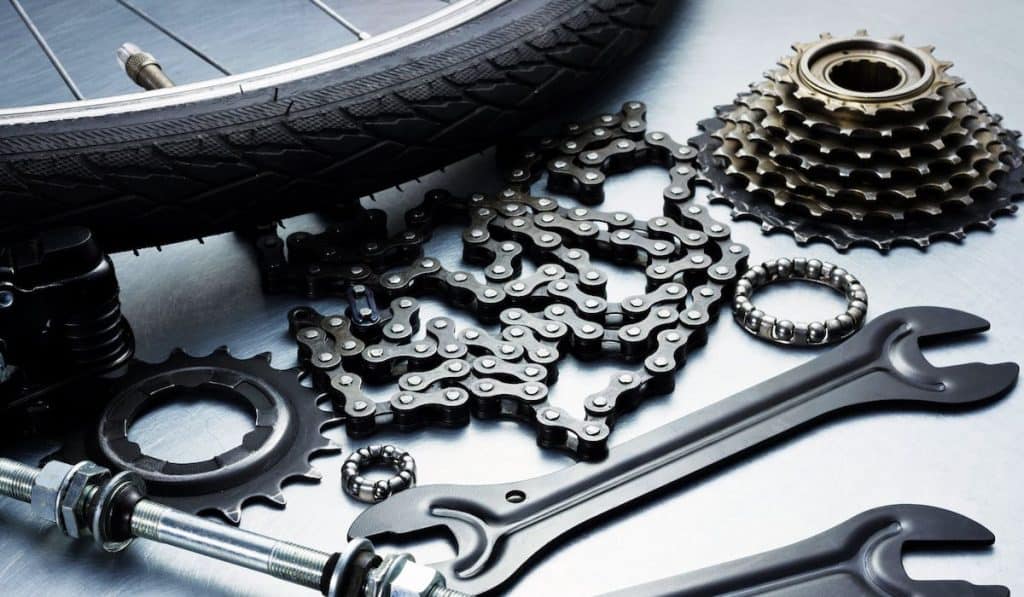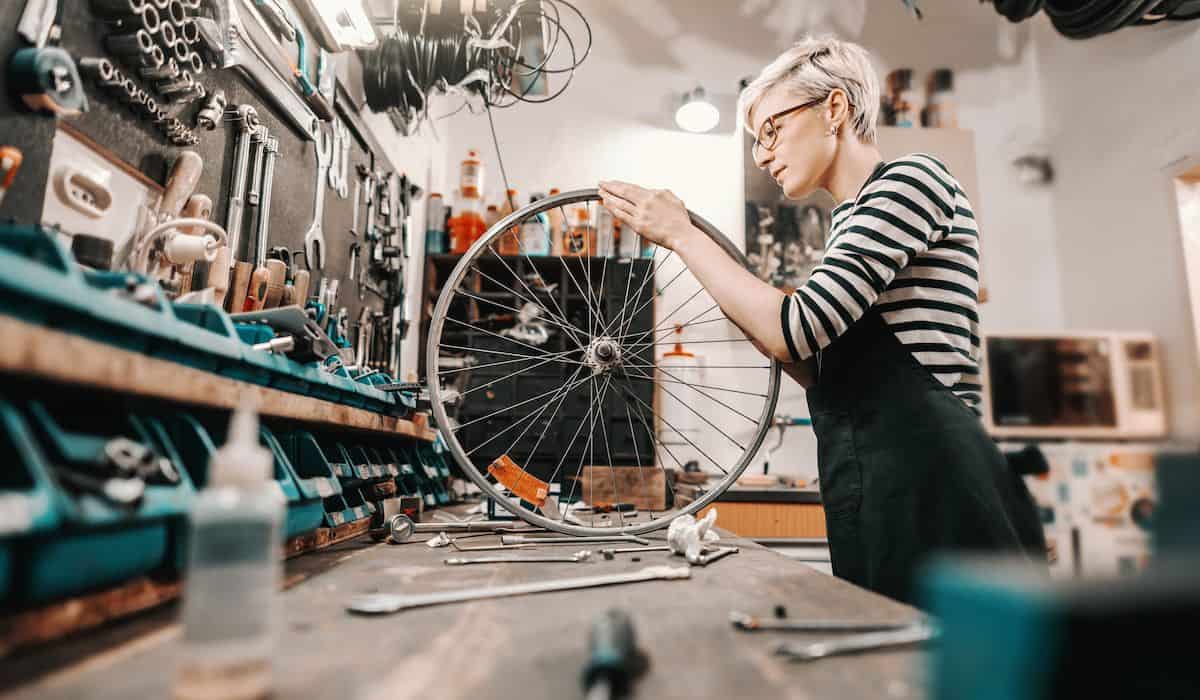When out Bikepacking, you will want to make sure that should the worst happen and your bike suffers a major fault that you have the means available to get it back in working order.
This is where a Bikepacking Tool Kit will come in handy and allow you to keep your bike in top condition as you are out adventuring. Within this article we will go over some of the top picks for these tool kits and some information on what you should look out for from your kit.
Top 5 Bikepacking Tool Kits
5. Editor’s Choice
- Newest Complete Bicycle Tool Kit with Torque Wrench
- The Bikehand Complete Bike Repair Tool Kit contains everything the home mechanic would need to maintain their bike. The 23 items in the tool kit are made to a very high standard and will make bike maintenance much easier. From tyre levers to bottom bracket installation tools, this tool kit will help keep your bike well maintained.
- The torque wrench, which is included in the kit, allows parts to be fit to manufacturer recommended settings, without over or under-tightening which can damage the component. Besides the satisfaction of completing bike servicing your self, the Bikehand tool kit will reduce those, often costly, bike workshop repair bills.
- Tough Heat Treated Steel
- ORDER NOW, WORRY-FREE! We’re so confident about the quality of our product that we can provide a one-year warranty! Made in Taiwan.
4. Budget Option
- ☆ COMPLETE TOOLBOX – The tool kit includes the most commonly used tools, and we also equipped this kit with several tools that are easy to carry, such as ratchet tools, tire repairs, foldable pliers, bone wrenches The kit can be used more widely. This bike tool kit can be used for home repairs or for outdoor cycling carry.
- ☆ HIGH QUALITY RATCHET BITSET. Mini ratchet With bitset are made of high quality carbon steel with harder steel version. Reversible Drive Ratchet wrench with adjustable left and right buttons. The compact snap system and magnetic bits make it easy to change bits and they do not fall off like conventional bits – Magnetic Bit Extender and Bit Set with 10 Screw Head Bits: 2mm / 3mm / 4mm / 5mm / 6mm / 8mm / T25 / T30 / PH1 / SL4.
3. Most Popular
- Chain rivet extractor (YC-336) for 7-11 speed for Shimano chain compatible, extra pin.Dust cap wrench (YC-27).Chainring nut wrench (YC-271).Flat 5mm/Phillips screwdriver (YC-611).8mm hex key wrench 1/2′ adaptor (YC-812LE)
- Flat screwdriver 3mm (YC-612).Tire lever set (YC-305D).YC-T20, YC-T25, YC-T30.Hex key wrench 2/2.5/3/4/5/6mm (YC-613-BK).3 Size bottom bracket wrench for for Shimano hollowtech II BB, BBR60 and BB9000 (YC-307BB)
- Freewheel and pedal wrench (YC-515) 15mm x 2, 11-speed cassette compatible.Freewheel tool (YC-126-1A).Cartridge bottom bracket tool (YC-26BB-1A).Master link tool 2-way function (YC-335CO).Chain hook (YC-207)
2. Fan Favorite
- 【Complete Bike Tool Kit】: The CYCLISTS 23 piece Bike Tool Kit contains all the tools to help you keep your bike in perfect working order, perform routine maintenance, repairs and upgrades.
- 【Easy to Use】: The Bike Repair Tool Box is a tool set for bike mechanics at home, work or on the road. If you are looking to maintain your own bike or wanting a mobile tool case to take on the road, the CYCLISTS bike tool kit will become a firm favorite for accomplishing your maintenance.
1. Must-have Option
- BIKE TOOL KIT: This starter tool kit includes Spoke Wrench, Chain Rivet Extractor, Socket 3 Way Wrench, Tire Lever, Cotterless Crank Tool, L Hex Key Wrench, Bottom Bracket Wrench, Wrench/Chain Whip, Two Hub Cone Spanners, Crank Arm Fixing Bolt, Cassette Removal with Pin, Bottom Bracket Tool, 14 in 1 Multi-Tool, Chain Wear Indicator, and Chain Ring Nut Wrench
- BASIC BICYCLE REPAIR KIT: Offers a 38-piece set of repair tools generally used on most bikes housed in a custom-molded case. This multi-tool bike kit is ideal for any home bicycle mechanic who wants the ultimate portable tool kit for mountain bike or road bike repairs
Buyer’s Guide: Bikepacking Tool Kits
How much will a Bikepacking Tool Kit cost and why?
As with any purchase, you are going to want to get the best value for the money that you can. Naturally, this will also be the case with your purchase of a Bikepacking Tool Kit.
In the case of Bikepacking Tool Kits, there can be a wide variation in the amount of cost that a tool kit can have and there are a few different reasons as to why the prices can differ, which we will now take a look at.
Generally, the price of these tool kits will increase as the quality of the materials used in the making of the tools and the number of tools available in the kit increase. Tools on the lower end will still be perfectly usable and will do a great job, it’s more of a question of how long they will be able to perform said job for.
A lower-end tool kit, at around $50 will give you tools that are made of metal that is generally either cheaper or has been machined in a way that is cheaper than the higher-end kits. This results in tools that are more prone to wear and tear in a shorter amount of time than more expensive ones.

One thing that you will tend to find in more expensive kits, from around $80 or up to even $150+ is that they will have tools that use high-quality metal that runs the whole length of the tool and then will have either polymer or rubber to allow you to better grip the tools.
Of course, using more metal of a higher-quality is going to run the price up by quite a bit, however, if you are serious about your Bikepacking it could well be worth your money to spend more on a tool kit that will last than multiple cheaper ones.
Lower end tool kits on the other hand may only offer metal in the parts of the tools that are closer to the contact end of the tool and then use polymer or rubber to bond to it part of the way up.
This provides a slight weak spot for these tools in that where the polymer and metal meet will be prone to either loosening with excessive use or snapping when met with too much force overtime.
These cheaper tools will still last you a good while if you treat them right but if you want the added security of knowing that your tools will last a very long time and keep you able to perform maintenance on your Bikepacking Bike then you may be better suited to splashing out a little more on your tools.
What tools will be in a Bikepacking Tool Kit and what purpose will they serve?
Knowing what is in your tool kit and what each tool can do for you is majorly important in getting the full use out of your equipment, and therefore your money. Whilst it might seem intimidating at first, most tool kits will come with a manual to instruct you on which tool is which and labeling within the container to inform you as to what goes where.
Wrenches
In your tool kit, one of the most common tools that you will find is a series of wrenches. In many different shapes and sizes, wrenches are extremely useful as they will allow you to remove the bolts that hold together your bike.
Types of wrenches you may find within your tool kit include torque wrench, chainring nut wrench, pedal wrench, hex key wrench, bottom bracket wrench, and a dust cap wrench. You will find that each of these wrenches will often have a different size. For example, one wrench could be 8mm whilst another is 6mm.
Screw Drivers
You will find that in most tool kits you will be provided with a couple of types of screwdriver or at least a driver with interchangeable heads. The heads you are most common to find are the same as you would usually find in any other tool kit, this being a Phillips or a Flathead type driver head.
These can be used to unscrew any fastenings that may be on your bike, for example, the saddle may have some screws in place for security.
Cable Cutters
Cable cutters are quite simply a tool that allows you to cut cables. For a bike, this will mostly come in the form of the brakes, and should you need to make changes to your brakes for any reason you will most likely need them.
These tools are excellent for when you need to perform some maintenance on your brakes and need to remove the cabling that makes up part of the system. Trying to dislodge these cables without cable cutters will be a hard time and these tools will make it so much easier.
Final Thoughts
To conclude, there are a range of different qualities of tool kit at different prices. Whether you need a quick solution with a cheaper tool kit, or a life-long set of equipment with a more high end kit there will be a good choice for you out there.
Hopefully this article has been good in showing you some of the options available and what you can expect from within your toolkit.





